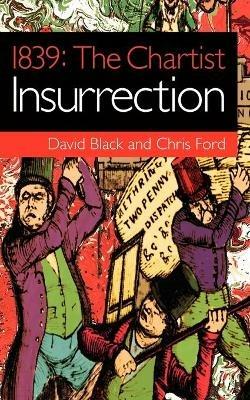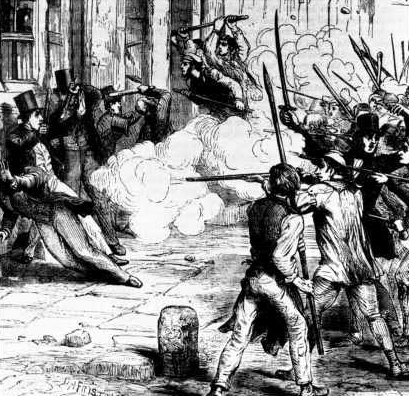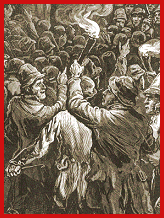
1839: The Chartist Insurrection. By David Black and Chris Ford
Unkant Publishing, London, 2012
From 2011 to 2015 Unkant Publishing brought out 14 great titles, including the above. In 2015, the company folded, leaving Unkant authors out of print and ‘homeless’. The following selection from what reviewers said about 1839: The Chartist Insurrection presents a good case, ten years on from publication, for a reprint.
1 – Ben Watson, Blurb
In retrieving the suppressed history of the Chartist Insurrection, David Black and Chris Ford have produced a revolutionary handbook

2 – Dan La Botz, New Politics
Black and Ford have written a fast-paced, narrative history of the 1839 Insurrection, filled with thumbnail sketches of the Chartist movement’s major figures, descriptions of the most important Chartist organizations and their politics in brief, excerpts from contemporary speeches, and parliamentary debates, and wonderful descriptions of the movement’s rise, growth, and spread throughout Britain. All of this is based on the most masterful command of the sources: newspapers, parliamentary records, memoirs, private papers, and all of the secondary literature. They tell their story in the most straightforward way but at a breathtaking clip that contributes to the sense of the excitement of the movement and its culmination in the insurrection.”
3 – Stephen Roberts, People’s Charter
I read this book in one sitting as I sheltered from the pouring rain at Bodnant Gardens in North Wales. Based on a wide range of secondary sources and easy to read, it provided a welcome way of spending a few hours whilst waiting for the weather to clear (it didn’t!). The authors tell the story of a year when they assert the conditions for a working class revolution existed. Their account, almost entirely based on such secondary sources as the studies of the Newport Rising by David Jones and Ivor Wilks (but noticeably omitting recent books by Malcolm Chase and Paul Pickering) cannot be said to add to the scholarship, but is full of vigour and engagement. Black and Ford see Chartism in 1839 as ‘a mass working class democratic movement with revolutionary and socialist tendencies’. So this is very much a political account from an avowedly Marxist stance. For the authors a hero of the Chartist story emerges … George Julian Harney. And rightly so: Harney should be a hero to us all.”
4 – R. Reddebrek, Goodreads
A very detailed and readable account of the early Chartist movement, its origins the personalities that came to dominate it and the events that spurred it on to physical force demonstrations culminating in the attempted insurrection in Southern Wales. It also comes with two appendixes that add further context to the time and give a voice to some of the Chartist leaders.

5 – Sharon Borthwick, Association of Musical Marxists, June 26, 2012
This was an exciting time… Dave Black and Chris Ford bring this time alive with this thoroughly researched book which includes many first hand accounts of meetings, battles and the colourful protagonists, many of who fully supported ‘ulterior measures’ in other words arming themselves, should parliament reject the petition for universal male suffrage which really they knew was a foregone conclusion…
This is a period soaked both in romance and horror and our heroes are both romantic and practical. The young George Julian Harney is just 21 when he joins the National Union of the Working Classes. He has been schooled on The Pilgrims Progress, Robinson Crusoe, The Castle of Otranto and the Sorrows of Young Werther. He sports a Jacobean red cap, which he likes to pass onto the heads of pretty young women who favour him with their singing binnies. He was a dogged agitator who travelled extensively to spread the Chartist message…
The momentum is all towards the final battles of 1839 when thousands are amassing in Wales and the North. Harney is finally furious with London as in the North strikes had begun, Manchester succeeding in closing 12 mills, the colliers of Northumberland downing tools. In Newport 6,000 men marched on Westgate but their leader has fled.
Some have lost their lives and many are imprisoned. Dr William Price escapes to Paris where he hangs out with the poet Heinrich Heine. We get glimpses of other characters. We don’t know much about him but that there was a £100 reward on his head, but we are glad that Dai the Tinker has escaped.
6 – Foreword, John McDonnell MP
… in most histories of the British Labour movement the story of the Chartists has focused on the large-scale mobilisations of petitioners, the development of mass-circulation radical newspapers for working people and the promulgation of the tactic of the general strike, the ‘sacred month’ or ‘big holiday’. The Newport Uprising and other attempts to use physical, as opposed to moral force have been, if not hidden from history, then at least pretty heavily disguised.
With its meticulous attention to detailed sources, its comprehensive scope and its exacting research, this book doesn’t just address the neglect of this important and interesting episode in Labour movement history, but more importantly it also challenges us to think again about the revolutionary potential of the British Labour movement.
Black and Ford evidence in a way others have failed to do the scale of the threat to the British establishment in 1839. Less than two centuries after an unlikely coalition of small landholders, Puritans, Ranters and Diggers had severed the head of an English king, this equally broad new alliance of Free Traders, Republicans, early Trade Unionists, proto-socialists and working people oppressed by poverty and the Poor Law raised again the standard of rebellion.
By challenging the prevailing hegemony relating to the events and significance of 1839, this book assists us greatly in understanding the potential for future challenges to the system.”
7 – James Heartfield, Spiked Online, June 2012
David Black and Chris Ford’s account of the Chartist uprising of 1839 is also written in part to save these agitators from the condescending judgement of an Althusserian, in this case Gareth Stedman-Jones, whose ‘fear of agency’ cannot recognise Chartism’s self-conscious attempt to overthrow ‘old Corruption’. 1839: The Chartist Insurrection is altogether a more rewarding read than Rancière’s for its unapologetic focus on people who are making their own history. Black and Ford make the case that the earlier 1839 uprising came closer to overthrowing the existing order than the later challenge of 1848. They situate the movement in the disappointment of the Reform Act of 1832 that gave the vote to middle- class property owners, but not to the working men who protested alongside them.
Black and Ford make a good case that, though the technology they worked with was not for the most part industrial, the core of the Chartist movement was much more than an outgrowth of radicalism. Of course, it was true that their Charter was a series of democratic demands – adult male suffrage, annual elections, paid Members of Parliament. On the other hand, popular among them was Gracchus Babeuf’s argument that the democratic revolutions in America and France left ‘the institutions of property’ intact as ‘germs of the social evil to ripen in the womb of time’. The common ambition among the Welsh miners that the owners be made to work their own mines tells us that their struggle for democracy was indeed mixed up with a class struggle between owners and hands.
As the authors show, the movement argued hard about how far it should go if its great petition, the Charter, on presentation to parliament, should be refused – as it was. The Chartist Convention, a national organisation with elected delegates, debated the use of ‘Ulterior Measures’ in that case.
George Julian Harney – anticipating modern Sinn Fein’s slogan ‘an armalite in one hand and a ballot paper in the other’ by 150 years – called on his audience to carry ‘a musket in one hand and a petition in the other’. Threatened with prosecution, many in the audience testified that he had in fact said ‘a biscuit in one hand…’. Arguing for the Ulterior Measures, Feargus O’Connor promised that ‘it would be a war of capital against labour, and capitalists would soon find out that labour was the only real capital in the world’.
Still, Black and Ford do not flatter the Chartists unduly, nor make them into cartoon heroes. All the weaknesses of the organisation are confronted here. Throughout the summer of 1839, there were a number of protests in towns across the north of England, notably Newcastle, and in Wales and Scotland, while many smaller groups took up the call to arm themselves. The planned general strike, or sacred month, though, was poorly executed and patchily observed. In some confusion and disarray, the Convention voted to dissolve itself after a number of setbacks.
As it turned out, the leaders’ retreat only opened the floodgates of a movement that was determined to fight on. Black and Ford tell the story of General Napier, who led the militia against the Chartists, though he was himself sympathetic to their cause, if not their methods. On 6 August 1839, Napier wrote: ‘The plot thickens. Meetings increase and are so violent, and arms so abound, I know not what to think. The Duke of Portland tells me that there is no doubt of an intended general rising.’ But Napier’s judgement is compelling: ‘Fools! We have the physical force, not they.’
Black and Ford tell a heartwrenching story of attempted insurrections in Bradford, Newcastle and, most pointedly, in Newport in south Wales, where the movement came to a head. The insurrection was led by the tragic figure of John Frost, who himself was hoping to dampen the movement down, explaining at his trial that ‘so far from leading the working men of south Wales, it was they who led me, they asked me to go with them, and I was not disposed to throw them aside’. Though the Chartists did succeed in taking the streets and the Westgate, their superior numbers were not enough to beat the special constabulary’s better organisation.
All over England, there were risings that failed to meet up, followed by suppression of the movement and a witch-hunt of the organisers. Some escaped, like Devyr, while John Frost was caught and tried – and would have been hanged but that the sentence was commuted to transportation (itself a sign that the authorities feared worse if they killed him). George Julian Harney concluded that ‘organisation is the next thing to be looked into.’

8 – Adam Buick, Socialist Standard, September 2012
The insurrectionary element in the Chartist movement has fascinated left-wing historians who see in it a frustrated revolutionary potential from which a modern vanguard can learn lessons.
Adding to this literature is a new history of the Chartist insurrectionaries of 1839 by David Black and Chris Ford (1839 –The Chartist Insurrection, London, Unkant Publishing, 2012, £10.99). It
is a compelling read, telling the story of Chartism through the experiences of George Julian Harney and other ‘firebrand’Chartist leaders such as Dr. John Taylor and examining the ill-fated Newport Rising of 1839. The authors provide a vivid account of the revolutionary potential that had built up in Britain by the late 1830s, culminating in the aborted rising at Newport in which several Chartists were killed.,,
The authors seem disappointed at what they see as the paucity of revolutionary leadership within the Chartist movement. The proposed general strike in support of the Charter is regarded as a failed revolutionary opportunity because Feargus O’Connor refused to see it as a chance for the “revolutionary seizure of power.” Black and Ford argue that “the strike had an inexorable revolutionary logic: with no strike fund to draw on, the people would have to violate bourgeois property rights in order to eat” (pp.88-9). But most Chartists did not want a revolutionary seizure of power; they wanted an extension of the vote backed by the threat that if it was not granted then ‘force’might follow. Chartist leaders such as O’Connor did not want a showdown with the state via a general strike because he knew that the likely consequence would be defeat.,,
The authors suggest that Chartism was neither the tail end of radicalism nor the forerunner of socialism. But it contained plenty of the old in with the new. In their words, “In 1839 the ideas of Thomas Paine stood in dialogue with the socialistic ideas of Thomas Spence, Robert Owen,“`
Bronterre O’Brien and Gracchus Babeuf” (p.199). Chartism was: “a conscious attempt by working-class insurgents to resolve …[capitalist] crisis by breaking the power of ‘Old Corruption’” (p.198). This is followed by the claim that “the movement undoubtedly did have:revolutionary and socialist tendencies which persisted and developed” (p.199). It is clear that the intellectual inheritance of Chartism was a mixed bag of traditional radicalism and new Socialism.
In trying to tell the story of insurrectionary Chartism, however, Black and Ford want to highlight a working class consciousness that is ripe for insurrectionary revolution. In so doing, although the story they tell was part of the Chartist movement, they highlight some voices in the movement at the expense of others.
Labour MP, John McDonnell, in the foreword to the book suggests that Black and Ford reveal that the threat to the British political establishment, even of revolution, in Britain in 1839 was closer than is often realized. This is indeed the main achievement of the book. But McDonnell also claims that the authors reveal a history that is suggestive of a possible “alternative revolutionary route” (p.xi) that could have been taken by British labour. This is to see a nascent revolutionary potential for seizing political power in the movement for democratic reform…
Black and Ford conclude that we should salute the Chartist insurrectionaries and seek to understand why they did not succeed in 1839. It is suggested that a major reason for their failure was weak revolutionary leadership. But, today, we have few positive lessons to learn from the bloody failure of past insurrections; less still do we need revolutionary leadership. Rather than inspiring an investigation into how such struggles can be harnessed by an enlightened cadre, it is the limitations of insurrection as a strategy for social change that strikes us. Armed insurrection was not necessary or even useful to the cause of democratic reform in Britain.
We should, of course, salute the Chartists but from a different perspective. They made bold and courageous sacrifices in the face of the determined opposition of the British state on behalf of their propertied opponents. And it is thanks to the struggles of the Chartists and of those who came after them that insurrection is more than ever a moribund revolutionary strategy. Since the late nineteenth-century the working class has possessed the political means to effect social and economic change. It is high time that we, the working class, had the confidence and knowledge to use those means for ourselves.
9 – Amazon Reviews
5.0 out of 5 stars Compelling, Entertaining and Well Researched
27 July 2012
In 1838 the London Working Men’s Association published The People’s Charter. This called for – the vote for all men; equal electoral constitituencies; payment for MPs with no need for MPs to own property; annual parliaments and a secret ballot.
1839: The Chartist Insurrection is the account of the dramatic struggle of the Chartists striving to achieve those aims in the face of the opposition of the British State. There are desperate coach journeys, mass meetings attended by tens of thousands across the country from Northumberland to South Wales. There is mass insurrection. Troops open fire killing protesters. More than reportage – David Black and Chris Ford give us a detailed account of the nitty gritty political organisation needed to run such a forceful national campaign. The lessons from The Chartist Insurrection are relevant to grass roots organisations who strive for real democracy in the face of the phoney democracy that is today’s British politics.
11 October 2019
Enjoyed this book very much
Helpful
Agn00
5.0 out of 5 stars Brilliant!
26 January 2017
Brilliant, in-depth history! Fantastic read!
Helpful
